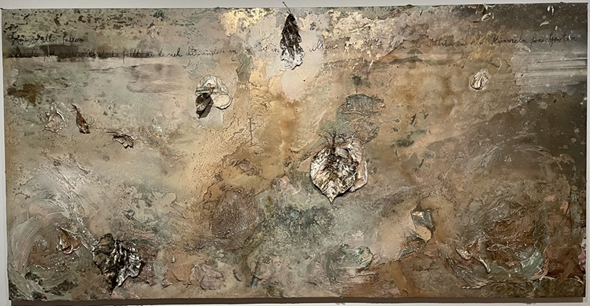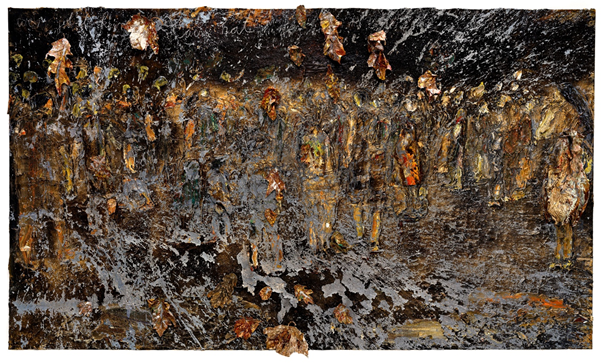The towering German artist, Anselm Kiefer, has worked continuously throughout his career to interrogate the socio-political history of Germany and the political ideology of fascism. From embodying and confronting fascism when enacting the ‘Sieg Heil’ salute in one of his earliest works, Für Jean Genet (For Jean Genet), c.1969, to wearing his father’s Wehrmacht overcoat in his self-portrait, Heroic Symbols (Self Portrait), c.1970, Kiefer’s conscious inheritance of recent and traumatic historical and cultural memory is evident, alongside his commitment to looking such atrocities in the eye, and refusing to forget what so recently happened, and could indeed happen again. Alongside the attention given to the political and culturally specific, Kiefer’s works frequently focus on landscapes and nature, exploring the way in which representations of landscapes within the Romantic tradition became associated with political ideologies under the Nazi regime. Kiefer’s work interrogates the cultural past and critically examines artistic traditions tainted by the Nazi regime. This exhibition, which shows paintings, drawings, photographs, woodcuts, and artist books made between 1969 and 1982, is psychologically heavy and dense in meaning, and urgently asks questions which could not be more apt in today’s alarming political climate.
Kiefer, who is now nearly eighty and lives and works outside Paris, has chosen three recent works from his studio for the opening space of the exhibition – three large, sculptural and surface-heavy landscapes. The exhibition then progresses back in time, exploring the process and development of Kiefer’s art over the years, and charting its development to his current works, which are typically large-scale, monumental and semi-abstract. Connecting each work in Anselm Kiefer: Early Works, is a sense of the heaviness and presence of Kiefer’s materials, and the way in which such materials suggest universal themes in life, from the nature of time and transient cycles of death and renewal, to mortality and decay. Kiefer’s diverse materials are combined to form condensed surfaces where multiple materials coagulate into matted and earthy clods, symbolising the stuff of the earth and the fundamental nature of mortality.
The three landscapes in the opening room of the exhibition encapsulate the distinctively layered nature of Kiefer’s practice: there are layers of meaning, including textual references (here the poetry of Rainer Maria Rilke), layers and amalgamations of materials typical of Kiefer’s work, and layers of memory, both cultural and personal. The Leaves are Falling, c.2017-23 – one of the large landscapes opening the exhibition, is made from emulsion, acrylic, oil, shellac, sediment of an electrolysis, lead and string on photography mounted on canvas, and is 126 x 250 cm. Like the work beside it, And at Night, The Heavy Earth Is Falling, 2017-23 (made of the same materials), the titles of these two works reference Austrian poet, Rainer Maria Rilke’s poem, Autumn, 1902, with a line from the poem streaking across the horizon line in a handwritten scrawl in The Leaves are Falling.
The Leaves are Falling is both immediate and tangible, with its large and sculptural leaves and its cracked and solid surface, whilst also being spacious and distant (with its faraway horizon line and a poetic feeling of sublime and endless space). The physically large size of The Leaves are Falling contributes to the sense of space, but it is also the suggestion of a heavy, moody sky, a dark horizon line and changing winds which creates an ominous mood. A sense of movement comes from the swirling murkiness of the paint-mixture in the foreground, along with the falling leaves (no doubt made sculptural with the use of shellac), which drift through the image like snow falling steadily in a snow globe: turbulence and quiet reflection; darkness and beauty; creation and destruction, these are a few of the contradictory themes in Kiefer’s works – which are always dense with meaning, yet delicate, poetic and universal. The feeling of darkness and despair is conveyed in the seemingly undefined and endless sense of space in this work – a common feature in so many of Kiefer’s large-scale works, which lack measurable parameters and instead suggest an endless abyss and an all-encompassing darkness, themes which reflect Kiefer’s response to the Holocaust and his inheritance of difficult and painful memories, both personally, politically and culturally.
Another of Rilke’s poems, Autumn Day, c.1902, has been printed alongside Autumn in the first room of the exhibition, accompanying the three recent works chosen by Kiefer. Autumn Day charts the inevitable passing of time, as defined by the seasons and the arrival of autumn, and ends with a melancholy reflection on the isolation of the hibernation months.
Autumn Day
Rainer Maria Rilke, c.1902 – ‘Autumn Day’, in The Selected Poetry of Rainer Maria Rilke, (trans.) Stephen Mitchell (New York, 1982), p.11.
Lord: it is time. The huge summer has gone by.
Now overlap the sundials with your shadows,
and on the meadows let the wind go free.
Command the fruits to swell on tree and vine;
grant them a few more warm and transparent days,
urge them on to fulfilment then, and press
the final sweetness into the heavy wine.
Whoever has no house now,
will never have one.
Whoever is alone will stay alone,
will sit, read, write long letters through the evening,
and wander the boulevards, up and down,
restlessly, while the dry leaves are blowing.
The combination of rich, natural beauty in Rilke’s poem, alongside stark and haunting isolation and loneliness (the manmade ‘boulevards’), combined with references to the closing in of winter and the perennial turning of the seasons, reflects the themes enmeshed in Kiefer’s works – the natural world paired with feelings of existential darkness, isolation and chaos – unsurprising themes for a German artist in the post-ward period, who has found his father’s Wehrmacht uniform in the attic at the age of 24, and is seeking to process the Nazi ideology of the Third Reich and the atrocities of the Holocaust. Writing of The Leaves are Falling and And at Night, The Heavy Earth Is Falling, curator of the exhibition, Lena Fritsch, comments that these works convey ‘an organic and natural feel’, and yet, like all of Kiefer’s work, a feeling of existential crisis pervade the paintings.

The third and largest abstract landscape in the opening room is Whoever has no House now, c.2023, as quoted from Autumn Day, and is made of emulsion, acrylic, oil, shellac, lead, string and chalk on canvas, stretching an impressive 330 by 190 cm. This work is even darker in both mood and colour than the other two landscapes, and has a more destructive, charged and foreboding feel.
Whoever has no House now is forceful, dense and full of drama, whilst also, with the shine of the shellac, and the encrusted nature of the surface, being arguably ugly. In fact, many of the works in this exhibition are not attractive, and neither are they likeable, but they instead present a challenge to the viewer and an intellectual and psychological puzzle, being created from symbolic, cultural, material, textual and personal layers which require thorough unpicking in order to reveal the multiple meanings ingrained in each one.

Review by Lucy Evans
Featured Image: The artist at work in his studio. Photo courtesy Barbara Klemm.
About the artist:
Born in Donaueschingen, southern Germany in 1945, Anselm Kiefer studied law, literature and linguistics before attending the Academy of Fine Arts in Karlsruhe, and later in Düsseldorf, during which time he had contact with Joseph Beuys. Kiefer was selected with Georg Baselitz for the West German Pavilion at the 39th Venice Biennale in 1980 and his work has since been shown in exhibitions across the globe. In 2020 Kiefer was honoured with a permanent installation of his work in the Panthéon in Paris, commissioned by President Emmanuel Macron.
Book tickets here (until 15 June 2025): https://www.ashmolean.org/exhibition/anselm-kiefer-early-works
Read our latest special feature In Conversation with Mister Geez: Capturing Spontaneous Urban Moments in Multicultural London